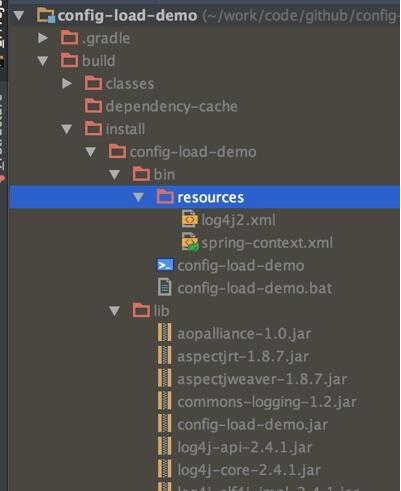gradle项目中资源文件的相对路径打包技巧必看
开发java application时,不管是用ant/maven/gradle中的哪种方式来构建,通常最后都会打包成一个可执行的jar包程序,而程序运行所需的一些资源文件(配置文件),比如jdbc.properties, log4j2.xml,spring-xxx.xml这些,可以一起打包到jar中,程序运行时用类似classpath*:xxx.xml的去加载,大多数情况下,这样就能工作得很好了。
但是,如果有一天,需要修正配置,比如:一个应用上线初期,为了调试方便,可能会把log的日志级别设置低一些,比如:INFO级别,运行一段时间稳定以后,只需要记录WARN或ERROR级别的日志,这时候就需要修改log4j2.xml之类的配置文件,如果把配置文件打包在jar文件内部,改起来就比较麻烦,要把重新打包部署,要么在线上,先用jar命令将jar包解压,改好后,再打包回去,比较繁琐。
面对这种需求,更好的方式是把配置文件放在jar文件的外部相对目录下,程序启动时去加载相对目录下的配置文件,这样改起来,就方便多了,下面演示如何实现:(以gradle项目为例)
主要涉及以下几点:
1、如何不将配置文件打包到jar文件内
既然配置文件放在外部目录了,jar文件内部就没必要再重复包含这些文件了,可以修改build.gradle文件,参考下面这样:
processResources {
exclude { "**/*.*" }
}
相当于覆盖了默认的processResouces task,这样gradle打包时,资源目录下的任何文件都将排除。
2、log4j2的配置加载处理
log4j2加载配置文件时,默认情况下会找classpath下的log4j2.xml文件,除非手动给它指定配置文件的位置,分析它的源码,
可以找到下面这段:
org.apache.logging.log4j.core.config.ConfigurationFactory.Factory#getConfiguration(java.lang.String, java.net.URI)
public Configuration getConfiguration(final String name, final URI configLocation) {
if (configLocation == null) {
final String configLocationStr = this.substitutor.replace(PropertiesUtil.getProperties()
.getStringProperty(CONFIGURATION_FILE_PROPERTY));
if (configLocationStr != null) {
ConfigurationSource source = null;
try {
source = getInputFromUri(NetUtils.toURI(configLocationStr));
} catch (final Exception ex) {
// Ignore the error and try as a String.
LOGGER.catching(Level.DEBUG, ex);
}
if (source == null) {
final ClassLoader loader = LoaderUtil.getThreadContextClassLoader();
source = getInputFromString(configLocationStr, loader);
}
if (source != null) {
for (final ConfigurationFactory factory : getFactories()) {
final String[] types = factory.getSupportedTypes();
if (types != null) {
for (final String type : types) {
if (type.equals("*") || configLocationStr.endsWith(type)) {
final Configuration config = factory.getConfiguration(source);
if (config != null) {
return config;
}
}
}
}
}
}
} else {
for (final ConfigurationFactory factory : getFactories()) {
final String[] types = factory.getSupportedTypes();
if (types != null) {
for (final String type : types) {
if (type.equals("*")) {
final Configuration config = factory.getConfiguration(name, configLocation);
if (config != null) {
return config;
}
}
}
}
}
}
} else {
// configLocation != null
final String configLocationStr = configLocation.toString();
for (final ConfigurationFactory factory : getFactories()) {
final String[] types = factory.getSupportedTypes();
if (types != null) {
for (final String type : types) {
if (type.equals("*") || configLocationStr.endsWith(type)) {
final Configuration config = factory.getConfiguration(name, configLocation);
if (config != null) {
return config;
}
}
}
}
}
}
Configuration config = getConfiguration(true, name);
if (config == null) {
config = getConfiguration(true, null);
if (config == null) {
config = getConfiguration(false, name);
if (config == null) {
config = getConfiguration(false, null);
}
}
}
if (config != null) {
return config;
}
LOGGER.error("No log4j2 configuration file found. Using default configuration: logging only errors to the console.");
return new DefaultConfiguration();
}
其中常量CONFIGURATION_FILE_PROPERTY的定义为:
public static final String CONFIGURATION_FILE_PROPERTY = "log4j.configurationFile";
从这段代码可以看出,只要在第一次调用log4j2的getLogger之前设置系统属性,将其指到配置文件所在的位置即可。
3、其它一些配置文件(比如spring配置)的相对路径加载
这个比较容易,spring本身就支持从文件目录加载配置的能力。
综合以上分析,可以封装一个工具类:
import org.springframework.context.ConfigurableApplicationContext;
import org.springframework.context.support.FileSystemXmlApplicationContext;
import java.io.File;
public class ApplicationContextUtil {
private static ConfigurableApplicationContext context = null;
private static ApplicationContextUtil instance = null;
public static ApplicationContextUtil getInstance() {
if (instance == null) {
synchronized (ApplicationContextUtil.class) {
if (instance == null) {
instance = new ApplicationContextUtil();
}
}
}
return instance;
}
public ConfigurableApplicationContext getContext() {
return context;
}
private ApplicationContextUtil() {
}
static {
//加载log4j2.xml
String configLocation = "resources/log4j2.xml";
File configFile = new File(configLocation);
if (!configFile.exists()) {
System.err.println("log4j2 config file:" + configFile.getAbsolutePath() + " not exist");
System.exit(0);
}
System.out.println("log4j2 config file:" + configFile.getAbsolutePath());
try {
//注:这一句必须放在整个应用第一次LoggerFactory.getLogger(XXX.class)前执行
System.setProperty("log4j.configurationFile", configFile.getAbsolutePath());
} catch (Exception e) {
System.err.println("log4j2 initialize error:" + e.getLocalizedMessage());
System.exit(0);
}
//加载spring配置文件
configLocation = "resources/spring-context.xml";
configFile = new File(configLocation);
if (!configFile.exists()) {
System.err.println("spring config file:" + configFile.getAbsolutePath() + " not exist");
System.exit(0);
}
System.out.println("spring config file:" + configFile.getAbsolutePath());
if (context == null) {
context = new FileSystemXmlApplicationContext(configLocation);
System.out.println("spring load success!");
}
}
}
注:这里约定了配置文件放在相对目录resources下,而且log4j2的配置文件名为log4j2.xml,spring的入口配置文件为spring-context.xml(如果不想按这个约定来,可参考这段代码自行修改)
有了这个工具类,mainclass入口程序上可以这么用:
import org.slf4j.Logger;
import org.slf4j.LoggerFactory;
import org.springframework.context.ApplicationContext;
/**
* Created by yangjunming on 12/15/15.
* author: yangjunming@huijiame.com
*/
public class App {
private static ApplicationContext context;
private static Logger logger;
public static void main(String[] args) {
context = ApplicationContextUtil.getInstance().getContext();
logger = LoggerFactory.getLogger(App.class);
System.out.println("start ...");
logger.debug("debug message");
logger.info("info message");
logger.warn("warn message");
logger.error("error message");
System.out.println(context.getBean(SampleObject.class));
}
}
再次友情提醒:logger的实例化,一定要放在ApplicationContextUtil.getInstance().getContext();之后,否则logger在第一次初始化时,仍然尝试会到classpath下去找log4j2.xml文件,实例化之后,后面再设置系统属性就没用了。
4、gradle 打包的处理
代码写完了,还有最后一个工作没做,既然配置文件不打包到jar里了,那就得复制到jar包的相对目录resources下,可以修改build.gradle脚本,让计算机处理处理,在代替手动复制配置文件。
task pack(type: Copy, dependsOn: [clean, installDist]) {
sourceSets.main.resources.srcDirs.each {
from it
into "$buildDir/install/$rootProject.name/bin/resources"
}
}
增加这个task后,直接用gradle pack 就可以实现打包,并自动复制配置文件到相对目录resources目录下了,参考下图:

最后国际惯例,给个示例源码:https://github.com/yjmyzz/config-load-demo
gradle pack 后,可进入build/install/config-load-demo/bin 目录,运行./config-load-demo (windows下运行config-load-demo.bat) 查看效果,然后尝试修改resources/log4j2.xml里的日志级别,再次运行,观察变化 。
以上这篇gradle项目中资源文件的相对路径打包技巧必看就是小编分享给大家的全部内容了,希望能给大家一个参考,也希望大家多多支持猪先飞。
相关文章
- 这篇文章主要介绍了详解如何将c语言文件打包成exe可执行程序,文中通过示例代码介绍的非常详细,对大家的学习或者工作具有一定的参考学习价值,需要的朋友们下面随着小编来一起学习学习吧...2021-02-25
将c#编写的程序打包成应用程序的实现步骤分享(安装,卸载) 图文
时常会写用c#一些程序,但如何将他们和photoshop一样的大型软件打成一个压缩包,以便于发布....2020-06-25- 这篇文章主要介绍了Pyinstaller打包文件太大的解决方案,具有很好的参考价值,希望对大家有所帮助。一起跟随小编过来看看吧...2021-03-09
详解SpringBoot之访问静态资源(webapp...)
这篇文章主要介绍了详解SpringBoot之访问静态资源(webapp...),文中通过示例代码介绍的非常详细,对大家的学习或者工作具有一定的参考学习价值,需要的朋友们下面随着小编来一起学习学习吧...2020-09-14- 这篇文章主要介绍了python打包生成so文件的实现,文中通过示例代码介绍的非常详细,对大家的学习或者工作具有一定的参考学习价值,需要的朋友们下面随着小编来一起学习学习吧...2020-10-30
- 这篇文章主要介绍了Maven打包的相关知识,本文给大家介绍的非常详细,对大家的学习或工作具有一定的参考借鉴价值,需要的朋友可以参考下...2021-09-13
解决Springboot整合shiro时静态资源被拦截的问题
这篇文章主要介绍了解决Springboot整合shiro时静态资源被拦截的问题,具有很好的参考价值,希望对大家有所帮助。一起跟随小编过来看看吧...2021-01-26- 这篇文章主要介绍了C#使用Dispose模式实现手动对资源的释放,涉及C#采用Dispose模式操作资源的技巧,具有一定参考借鉴价值,需要的朋友可以参考下...2020-06-25
- 这篇文章主要介绍了vue cli3 实现分环境打包的步骤,本文通过图文并茂的形式给大家介绍的非常详细,对大家的学习或工作具有一定的参考借鉴价值,需要的朋友可以参考下...2021-03-12
- 本文主要介绍了webpack搭建脚手架打包TypeScript代码,文中通过示例代码介绍的非常详细,具有一定的参考价值,感兴趣的小伙伴们可以参考一下...2021-09-21
- 这篇文章主要介绍了编译打包video.js的方法,本文通过图文并茂的形式给大家介绍的非常详细,对大家的学习或工作具有一定的参考借鉴价值,需要的朋友参考下吧...2020-12-09
- 本文主要介绍了Vue打包后页面出现空白解决办法,文中通过示例代码介绍的非常详细,具有一定的参考价值,感兴趣的小伙伴们可以参考一下...2021-08-03
- 经常看到有人踩在了PHP路径的坑上面了,感觉有必要来说说PHP中相对路径的一些坑,以及PHP中绝对路径的使用,下面一起来看看。 ...2016-08-24
- 这篇文章主要介绍了基于Python正确读取资源文件,文中通过示例代码介绍的非常详细,对大家的学习或者工作具有一定的参考学习价值,需要的朋友可以参考下...2020-09-14
Shell脚本构建Docker 半自动化编译打包发布应用操作
这篇文章主要介绍了Shell脚本构建Docker 半自动化编译打包发布应用操作,具有很好的参考价值,希望对大家有所帮助。一起跟随小编过来看看吧...2021-03-30- 本文主要介绍了Qt使用windeployqt工具实现程序打包发布方法,文中通过示例代码介绍的非常详细,具有一定的参考价值,感兴趣的小伙伴们可以参考一下...2021-11-01
- 这篇文章主要介绍了Java jar打包工具使用方法步骤解析,文中通过示例代码介绍的非常详细,对大家的学习或者工作具有一定的参考学习价值,需要的朋友可以参考下...2020-10-15
- 这篇文章主要介绍了教你怎么用Idea打包jar包,文中有非常详细的代码示例,对刚开始使用IDEA的小伙伴们很有帮助哟,需要的朋友可以参考下...2021-05-12
Python selenium 自动化脚本打包成一个exe文件(推荐)
这篇文章主要介绍了Python selenium 自动化脚本打包成一个exe文件,本文通过实例代码给大家介绍的非常详细,具有一定的参考借鉴价值,需要的朋友可以参考下...2020-04-27- 本文主要对相对路径和绝对路径的写法进行总结。具有一定的参考价值,下面跟着小编一起来看下吧...2020-06-25
